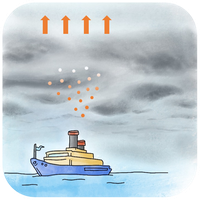Marine Cloud Brightening (MCB)
What is Marine Cloud Brightening?
This potential climate intervention technique modifies the albedo of the low clouds over water by introducing cloud condensing nuclei-effective aerosols to produce a larger amount of smaller in size cloud droplets that reflect more sunlight back into space. Latham et al. (2008) estimated that a 6% increase of the albedo of marine stratocumulus clouds can offset the warming caused by the CO2 doubling.
A natural analogue for this solar radiation modification deployment comes from ship exhaust aerosol particles directly entering marine stratocumulus clouds (Christensen and Stephens, 2011) altering cloud microphysical and macrophysical properties. Cloud albedo responses to ship tracks depends on several parameters such as the mesoscale cloud structure, the free tropospheric humidity, and cloud top height (Chen et al., 2012).

Marine Cloud Brightening - the benefits and options
The ACtIon4Cooling project will evaluate the effectiveness in producing measurable cooling of the Earth system - at global and regional scale - resulting from MCB deployment.
The project will analyse marine clouds that are co-located with ship-track signatures over the Mediterranean Sea (and elsewhere): Changes in cloud cover and reflectivity of those marine clouds with ship emission signature will be evaluated.
Marine cloud properties will come initially from the spaceborne Ultraviolet Visible Near-infrared (UVN) spectrometers, such as TROPOMI on Sentinel-5 Precursors (Veefkind et al., 2012). The TROPOMI operational algorithms for the retrieval of cloud parameters (Loyola et al., 2018) make use of Earth-shine reflectance measurements in the spectral windows of UV, VIS and NIR. Complementary information for the marine clouds captured by TROPOMI instrument will be exploited from VIIRS on Suomi-NPP. The MCB aerosol information is captured by the TROPOMI sensor in the Oxygen absorption bands (i.e., Aerosol Layer Height), and in the UV spectral window as well. In particular, the ultraviolet (UV) Absorbing Aerosol Index (AAI) is widely used as an indicator for the presence of absorbing aerosols in the atmosphere (Kooreman et al., 2020; Torres et al., 1998a). The ship-track signature of aerosols in the TROPOMI cloud retrievals will be investigated via the scientific NASA TropOMAER (TROPOMI aerosol algorithm), which simultaneously retrieves aerosol optical depth (AOD), single-scattering albedo (SSA), and the qualitative UV aerosol index (UVAI) (Torres et al., 2020).
Validation of the MCB dataset is foreseen for the marine clouds captured by PANGEA (PANhellenic GEophysical observatory of Antikythera) observatory at the island of Antikythera (35.861N, 23.310E, 110m a.s.l). PANGEA is an active member of ACTRIS and AERONET network and a satellite Cal/Val center in the Mediterranean region. Validation of the MCB dataset will be strengthened from the ESA funded experimental campaigns (e.g. the ASKOS experiment). Finally, the ESA EarthCARE mission (Illingworth et al. 2015, Wehr et al., 2023), supported by the complementary datasets of the NASA PACE mission (Werdell et al., 2019), offers the opportunity to exploit novel parameters of the aerosol-cloud system.

